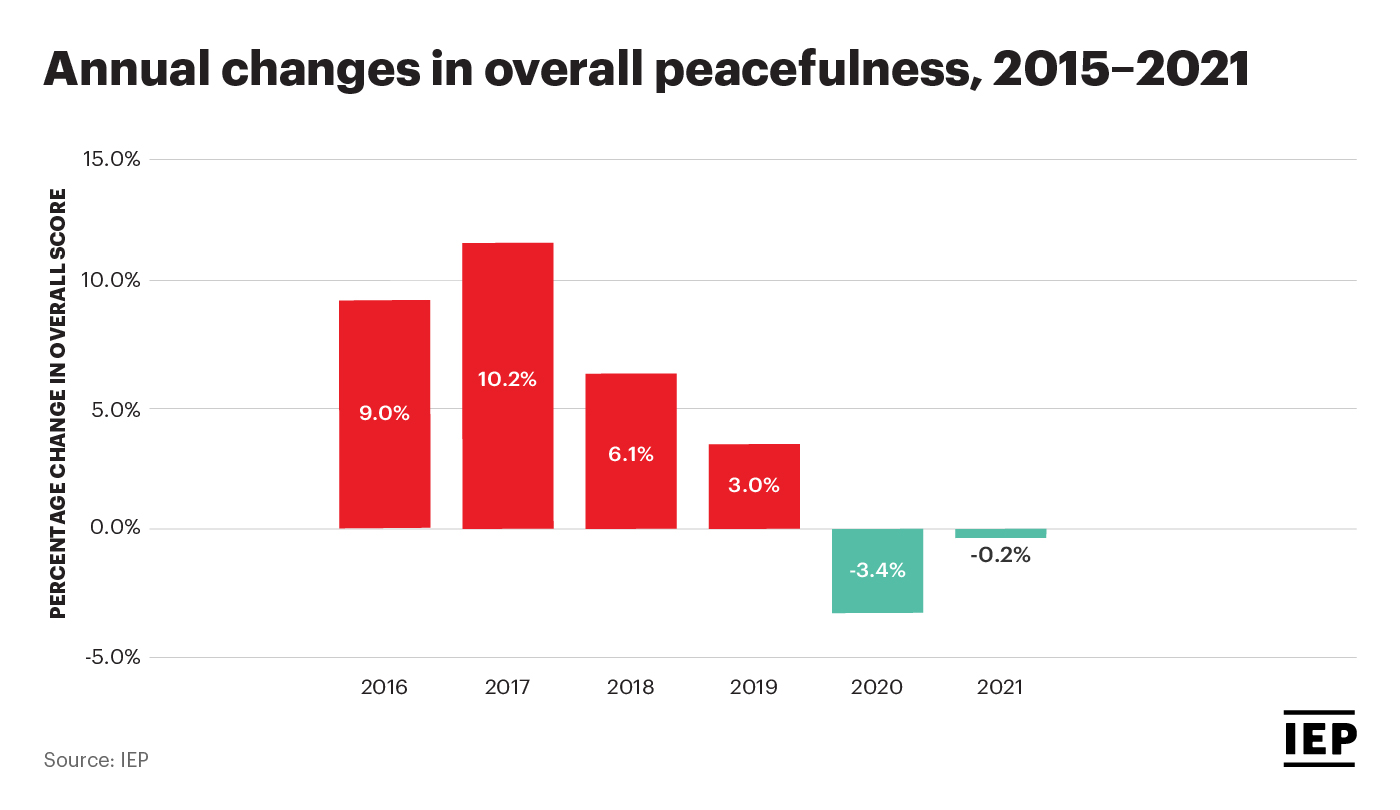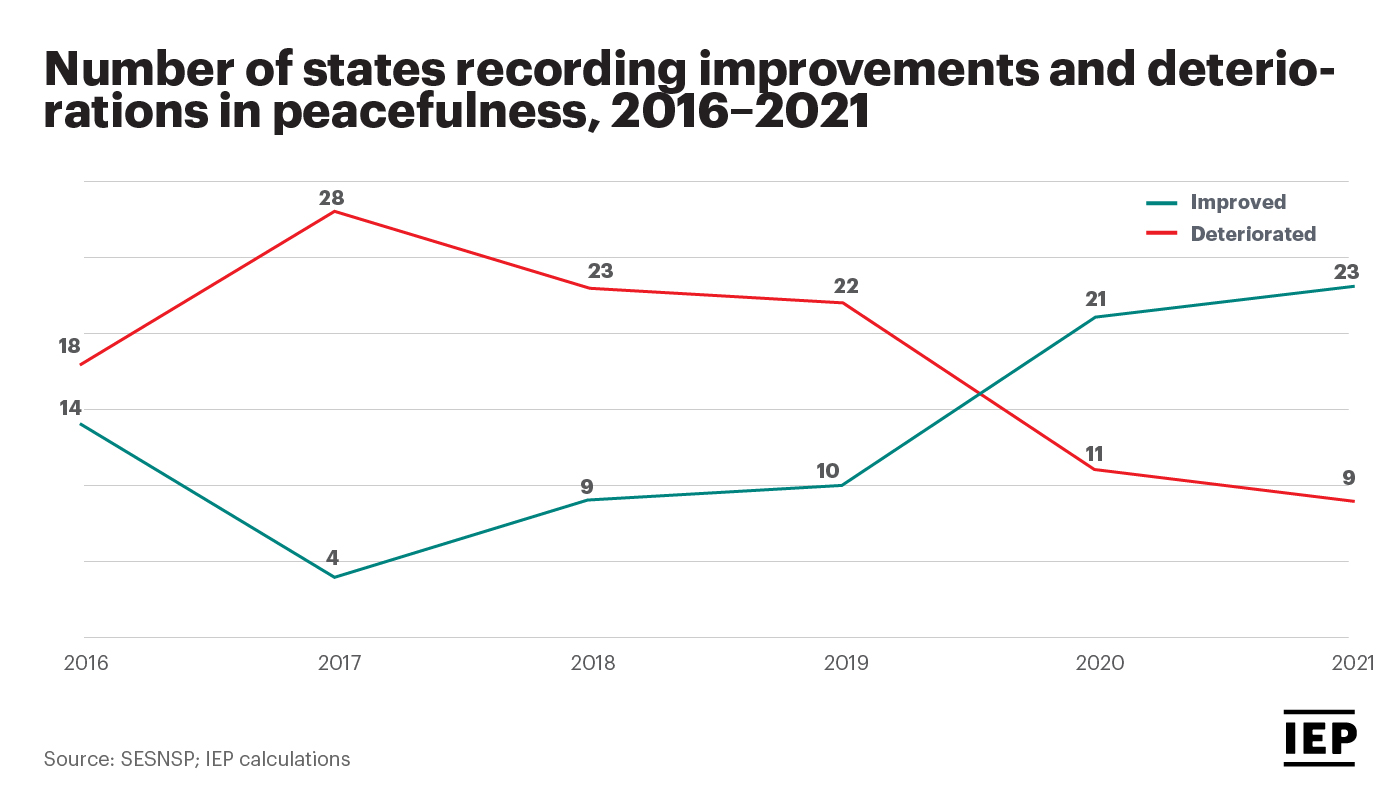Since 2015, peacefulness in Mexico has deteriorated by 17.1 percent. As shown in the figure below, the overall deterioration occurred between 2015 and 2019, with minor improvements recorded in the past two years, including a 0.2 percent improvement in 2021. The drivers behind this shift in the past two years are multifaceted, but they are critical to understanding Mexico’s path towards peacefulness in a post-pandemic environment.

Crucially, the shift of the past two years can be linked to widespread reductions in homicide and gun violence. Since peaking in 2019, Mexico’s homicide rate has improved by 5.6 percent, with 21 states improving. Nevertheless, the improvements of the past two years have been minor in comparison to the deteriorations experienced before them.
Between 2015 and 2019, the deterioration in peacefulness was primarily driven by deteriorations in the homicide and firearms crime scores. Firearms crime recorded the largest deterioration of all MPI indicators, with its rate increasing by 77.9 percent. Reflecting this increase in gun violence, the proportion of homicides committed with a firearm rose from 57.4 percent in 2015 to 68 percent by 2021. During the same period, the proportion of male homicides committed with a firearm rose from 60.9 percent to 71.3 percent, while the proportion of female firearm homicides rose from 37.8 percent to 56.8 percent. This latter point is significant because it means that, in past seven years, guns have become the primary means of women being killed in Mexico.
Overall, the homicide rate has risen by 76.3 percent since 2015. Mexico has recorded more than 34,000 homicides in each of the past four years, and the country’s homicide rate of 26.6 deaths per 100,000 people is the eighth highest rate in the world.
In the past two years, more states have improved than deteriorated, with 2021 witnessing the highest number of improving states in the past seven years, as shown in the figure below. Despite the vast majority of states improving in peacefulness in 2021, the national peace score experienced only a marginal improvement. This reflects the degree to which deteriorations in a minority of states are driving the overall elevated levels of violence in Mexico.
As in 2020, just six states – Guanajuato, Baja California, the state of México, Michoacán, Chihuahua and Jalisco – accounted for approximately half of all homicides. Reflecting the significant divergence in levels of violence across the country, the average homicide rate in Mexico’s five least peaceful states was 73 per 100,000 people, compared to 8.2 per 100,000 people in its five most peaceful states.

Recent improvements have also coincided with public health measures and stay-at-home orders implemented in response to the COVID-19 pandemic, with a large reduction in opportunistic crimes recorded in 2020. These measures significantly reduced mobility and therefore reduced opportunities for criminal groups to target victims in public. As such, crimes typically associated with people’s everyday movements, such as robberies, assaults, kidnappings and extortion, all experienced notable reductions in 2020. However, as measures have been lifted and normal activities have resumed, many of these have rebounded to pre-pandemic levels in 2021.
Conversely, specific types of interpersonal violence, such as family violence and sexual assault, increased during the pandemic. In the case of family violence, research indicates that the stay-at-home orders may have reduced victims’ willingness and ability to report the assaults. For example, in Mexico City, while reported cases of family violence fell in April 2020, the first full month of lockdown measures, there was a spike in the number of family violence calls to the city’s emergency hotline for women. Although official reports declined during the first few months of stay-at-home measures, by the end of 2020 the rates of family violence and sexual assault had returned to pre-pandemic levels, and in 2021, both indicators recorded steep increases.
In line with steep increases in violence, Mexico’s socio-economic resilience, as measured by Positive Peace, has deteriorated by 1.1 percent since 2009. The largest deteriorations were recorded in the Well-Functioning Government, Low Levels of Corruption and Good Relations with Neighbors Pillars. IEP research also found that, at the state level, corruption and administrative ineffectiveness enable crime and violence through misallocating funds that could otherwise have been dedicated to public security. The lack of political rights and civil liberties also show an association with higher levels of violence and crime.
However, Mexico ranks 76th out of 163 countries in the Positive Peace Index, in contrast to its 140th position in the Global Peace Index, meaning that despite the public security crisis, Mexico does have the social conditions that would allow it to aspire to a more sustainable peace.
Effective peacebuilding strategies will need to look at multiple dynamics and how they interact, and the Pillars of Positive Peace provide a systemic lens to analyze societal issues facing the country. Combating corruption and inefficiencies in business, government and other institutions would not only reduce impunity and crime, but also free up funds and resources for much needed investment. In addition, showcasing and replicating success stories of peace and resilience-building programs could lead Mexico into a virtuous cycle towards higher levels of peacefulness.